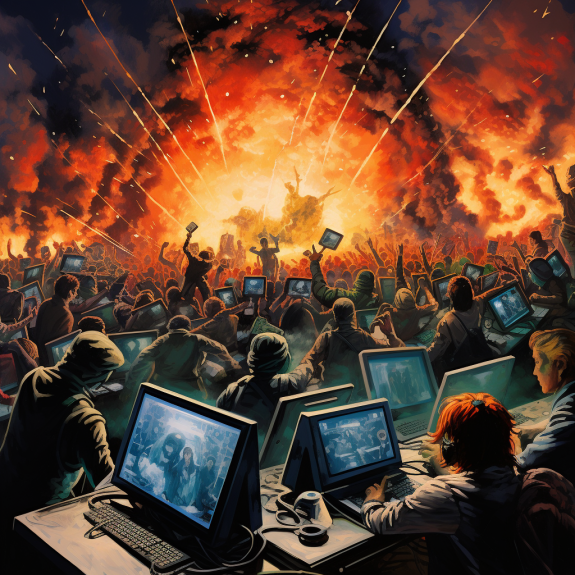I encountered an interesting essay titled, ‘Maneuver Warfare Is Not Dead, But It Must Evolve.’
Context: Here’s an excerpt from the essay for those not familiar with what is meant by maneuver warfare:
Critics too often conflate the maneuver warfare concept with maneuver/movement. The former “seeks to shatter the enemy’s cohesion through a variety of rapid, focused, and unexpected actions.” Rapid movement is part of it, but so is firepower/destruction. The key is to avoid applying fires purely in an extended grinding down of an enemy’s defenses and instead focus on rendering the enemy incapable of effective counteraction “by shattering their moral, mental, and physical cohesion—their ability to fight as an effective, coordinated whole.”
Apparently, many military analysts and scholars are favoring attrition over maneuver warfare these days. The authors write a good defense of maneuver warfare and describe ways it must adapt, but they don’t touch on a larger vulnerability the US will face in future conflict: the challenge networked activism (& the moral realm of warfare) poses to attrition warfare.
Swarming and the Future of Conflict
In Swarming and the Future of Conflict, John Arquilla & David Ronfeldt described the potential for militant NGOs and other civil society actors to use swarming as a means of constraining the US.
“militant NGOs and other civil society actors will find swarming a useful means for engaging as well as constraining the United States. Looking across the spectrum of conflict, we sense a likelihood that swarming will be featured more often in the low-intensity conflicts (LICs) of the near future. It is a natural doctrine for networked organizations to apply, and the most networked groups extant are those operating at the nonstate level.”
…
“At present, our best understanding of swarming—as an optimal way for myriad, small, dispersed, autonomous but internetted maneuver units to coordinate and conduct repeated pulsing attacks, by fire or force—is best exemplified in practice by the latest generation of activist NGOs, which assemble into transnational networks and use information operations to assail government actors over policy issues. These NGOs work comfortably within a context of autonomy from each other; they also take advantage of their high connectivity to interact in the fluid, flexible ways called for by swarm theory.”
Following the invasion of Ukraine by Russia, we witnessed networked swarming attacks. Governments, media, financial institutions, corporations, NGOs, hackers, influencers, and other non-state actors started launching a campaign against Russia.
On October 7, Hamas leader Abroad Khaled Mashal appeared on Turkish television. He referenced a new global network, the “global left,” and outlined how networks could be used against the US and Israel,
“We have friends among the Christians, even among the Jews, as well as the global left. … I am also addresing Moscow and Bejing… They can do more. They should build the determination… Enough, the [American] monopoly… This is an opportunity. Moscow and Bejing are striving for an international balance of power that will abolish [American] unipolarity. Well, this is your opportunity.”
As Israel began its offensive in Gaza, the mobilization of these networked activists, the global left, became apparent on social media and as mass demonstrations appeared across the globe.
The Tribal War Over Israel
John Robb described the environment in his article, The Tribal War over Israel,

“Israel’s war with Hamas is part of a more extensive information war with a global, networked tribe. Israel is losing that larger struggle.”
Some more excerpts:


I recommend his article to understand the greatest vulnerability to attrition warfare – unaddressed by the author of the essay I opened with.
Unrestricted Warfare
Networked activism is just one element of the types of combination attacks prescribed by Wang Xiangsui and Qiao Liang in Unrestricted Warfare. If we view the current conflict through the filter of Unrestricted Warfare, we could imagine a combination attack which looked something like:
terrorism (to exploit asymmetry of power – provoking a response with heavy civilian casualties) 1
+
information war (empathy triggers, moral framing, pattern-matching, fictive kinship) 2
+
networked activism (both online & offline)
+
refugees to increase societal disruption in Western nations who accept them 3
+
resource exhaustion (unlimited responsibilities with limited means) as assets move to region 4
+
supply chain disruptions (with Houthi attacks, etc)
+
… etc
Conflict has evolved & state actor needs to re-orient and adapt.
John Boyd 1991 Congressional Testimony
Adding:
After I published this article, I came across testimony John Boyd provided in a 1991 congressional hearing (after reading an article from Mark McGrath). Boyd spoke of the introduction of Maneuver Warfare into Marine manual FMFM1. He explained the officer resonsible was being forced into early retirement and explained the threat the “dinosaurs” who would undo maneuver warfare posed.
“In 1989, the Marine version of maneuver warfare was officially proclaimed in their new war-fighting manual, FMFM1. Colonel Wiley (sp) and his ideas had finally arrived. Or had they? For his untiring and courageous efforts, Colonel Wiley (sp) has been recently informed by a Marine board of officers that he must take an early retirement, eight months early. This would suggest there are some, maybe even many, senior Marine officers who would still like to retain the old attrition war-fighting mind set despite the use of Wiley’s (sp) ideas, which contributed mightily to a relatively painless, extremely low-casualty military victory.
“Why should we make such a fuss only over one colonel? First, because, if nothing is done about Colonel Wiley (sp), for at least the next four years, young officers in the Marine Corps will be inhibited from proposing important, perhaps crucial new ideas. Secondly, if nothing is done about Colonel Wiley and the people who forced him out, then the Marine Corps will be left in the hands of what I might add I would call “dinosaurs,” who will undo the maneuver warfare ideas that worked so well for the Marines in the Gulf.”
Boyd: “Wars fought without innovative ideas become bloodbaths – winnable or not.”
Later in the hearing, Boyd says,
“But mostly when you look at these schools — I don’t care whether you’re talking about Leavenworth or the Marines or elsewhere, even if they’re doing it from an historical viewpoint, they are primarily looking at it from strictly a physical viewpoint. In other words, trying to get in the back door, and how troops move in the field. And in some sense, they’re really not come to grips in a very positive sense with the mental and moral effects that you can produce.
“In other words, how can you set it up ahead of time? In other words, instead of having it happen accidentally to generate these mental/moral effects where you can just literally pull your adversary apart so he can’t even function as an integrated organism. And there are ways that that can be done, and I would say that part hasn’t been stressed. And if you’re going to talk about future warfare, or future conflict, whether you’re going to talk about conventional forces, unconventional forces, surrogate, whatever you want to talk about, you are going to have to get more and more into that. Because if you don’t, your adversary is. And we could have some very serious consequences.”
Of note: Unrestricted Warfare was published after the Chinese officers studied the first Gulf War.
I want to add this important remark From Boyd’s opening statement:
“…we need to understand there’s a difference between physical courage in battle and the moral courage that is required to introduce and implement new ideas in military bureaucracies. If you haven’t been there, you can’t imagine the intense pressures and high career risks facing a young officer who, out of conscience, is trying to introduce unconventional new ideas. In my opinion, officers with physical courage are far more abundant than officers with the moral courage I have just described.”
Notes:
- Unrestricted Warfare describes how asymmetry can be exploited: “[asymmetry] often makes an
adversary which uses conventional forces and conventional measures as its main combat strength look like a big elephant charging into a china shop. It is at a loss as to what to do, and
unable to make use of the power it has.”
from Beautiful Trouble: “If you design your action well, you can force your target into a situation where they have no good options: where they’re “damned if they do, and damned if
they don’t.” This is known as a decision dilemma.” ↩︎ - see John Robb’s work: https://substack.com/@johnrobb ↩︎
- “Like immigration and refugee policy more generally, real and threatened migration crises tend to split societies into (at least) two mutually antagonistic and often highly mobilized groups: the pro-refugee/migrant camp and the anti- refugee/migrant camp.” This domestic disagreement can be exploited by “challengers on the international level [who] seek to influence target behavior on the domestic level by engaging in a kind of norms-enhanced political blackmail”—a “potential wedge through which they can inflict pain that can endanger a leader’s relationship with his or her core supporters or even stimulate general unrest within a target state.” Source: Migrants as Weapons Systems: https://jnslp.com/2022/12/16/migrants-as-a-weapons-system/ ↩︎
- From Unrestricted Warfare: “Americans tend to pursue unlimited objectives as they expand their national power. But this is a tendency which in the end will lead to tragedy. A company which has limited resources but which is nevertheless keen to take on unlimited responsibilities is headed for only one possible outcome, and that is bankruptcy.” ↩︎

